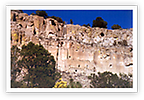Puye Cliff Dwellings and Welcome Center

Categories
Arts and CultureEntertainmentRestaurantsRetail Stores
Hours:
April - September
Gates open at 8:30am
Tours start at 9 am and continue on the hour until 5 pm.
About Us
Puye Cliffs was home to 1,500 Pueblo Indians who lived, farmed and hunted game there from the 900s to 1580 A.D.
Puye Cliffs' inhabitants then moved into the Rio Grande River valley. They became the ancestors of today's Santa Clara people, who now live at Santa Clara Pueblo, 10 miles east of Puye.
Puye Cliffs comprises two levels of cliff and cave dwellings cut into the cliff face, as well as dwellings on the mesa top. Over one mile long, the first level runs the length of the base of the mesa. The second level is about 2,100 feet long. Paths and stairways were cut in the face of the rock to connect the two levels and allow people to climb to the top of the mesa.
Representing early Pueblo architecture, cave dwellings on the mesa top were part of a single, multi-storied complex built around a large, central plaza. While the total number of rooms is unknown, the south part of the complex had 173 on the ground floor and multiple stories in various places, similar to modern-day Taos Pueblo.
The largest of all settlements in the Pajarito Plateau, Puye Cliffs was excavated in summer 1907 by Edgar Hewitt in cooperation with the Southwest Society of the Archeological Institute of America. Puye was the first of the ancient pueblos of the Rio Grande Valley to be systematically excavated.
It was also named a National Historic Landmark in 1966.
